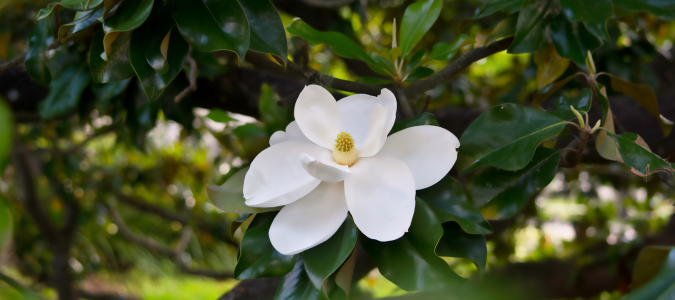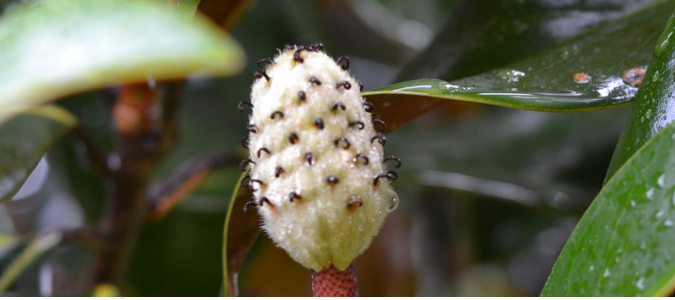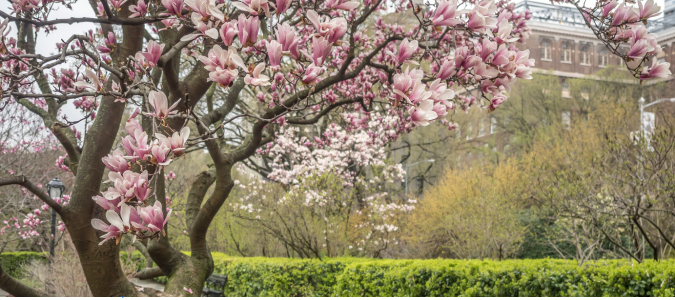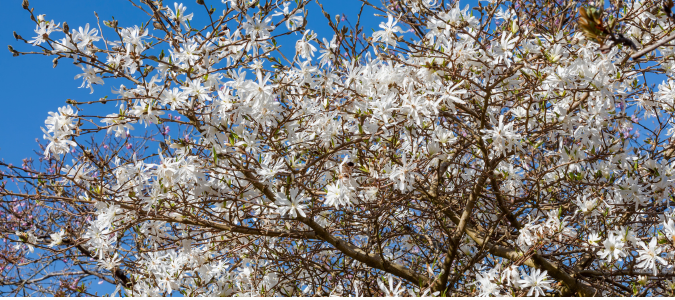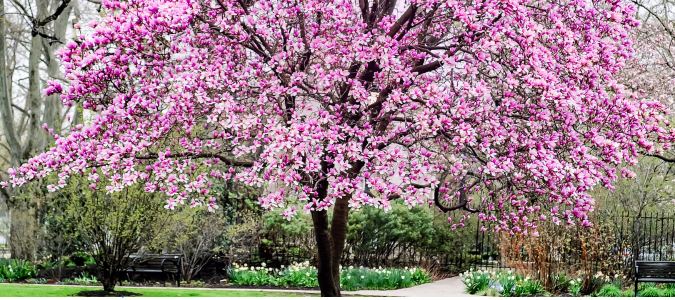Did you know that there are more than 200 species of magnolia trees? In Central Texas, four main types thrive in our warm weather and sunlight: southern magnolia trees, little gem magnolia trees, saucer magnolia trees and star magnolia trees.
Each type of magnolia tree produces stunning flowers that make them the focal point of any lawn or garden. However, they have different care and maintenance needs, so it’s helpful for homeowners to understand the difference between each type.
Southern Magnolia
The southern magnolia tree, pictured above, is beloved for its large, velvety, dark green leaves. It grows larger than other types of magnolia trees, and some can reach up to 80 feet tall. Because of its noble size and appearance, this tree is also known as the “Grand Dame” of the magnolia tree family.
Southern magnolia trees produce beautiful and fragrant white flowers that grow as large as 12 inches in diameter. With its large size, elegant leaves and stunning flowers, the southern magnolia is a striking addition to any lawn.
To care for a southern magnolia, you must provide it with well-drained, acidic soil. These trees thrive in full sun and partial shade. Young southern magnolia trees need plenty of water to establish deep roots, especially during the hot summers in Central Texas.
Adding mulch to the tree’s base is one way to help southern magnolia trees retain their moisture.
Pruning is often not necessary for southern magnolias unless you need to remove dead leaves or diseased branches. Contact your local lawn care specialist for more tips on how to maintain a thriving southern magnolia tree.
Little Gem Magnolia
The little gem magnolia, pictured above, looks strikingly similar to the southern magnolia; however, it only grows up to 20 feet tall. It’s often referred to as the “compact southern magnolia.” If you want the same beautiful look of a southern magnolia with a smaller footprint, the little gem is a great option for your lawn.
Like southern magnolias, little gem magnolias produce beautiful white flowers and have glossy dark green leaves.
Caring for little gem magnolia trees is similar to caring for southern magnolia trees; however, little gems need even more water than southern magnolias in dry and hot seasons due to their smaller root systems. Regularly fertilizing little gem magnolias will help them continue to produce beautiful and healthy flowers.
Saucer Magnolia
Next, the saucer magnolia tree is known for its gorgeous pink flowers, which bloom in a saucer-like shape in early spring. In April and May, these breathtaking flowers take over the entire tree and create a stunning sight.
Saucer magnolia trees also produce white and purple flowers, along with white and pink flowers. These trees produce simple dark green leaves in the summertime. Their light gray bark is another identifying feature.
These magnolias are deciduous trees, meaning they lose their leaves yearly. In the fall, the green leaves turn yellow and brown before eventually falling to the ground. When fall turns to winter, the saucer magnolias begin producing green buds that grow at the tips of the branches and eventually blossom into flowers in the spring.
Saucer magnolia trees need well-drained soil and consistent moisture during the growing season. They prefer full sun to partial shade. To maintain the shape of the tree, prune them after they flower. Pruning is also beneficial for removing dead and overcrowded branches. For more tips on how to care for a saucer magnolia tree, contact a lawn care professional.
Star Magnolia
As their name suggests, star magnolia trees produce beautiful star-shaped flowers in the early spring. Out of the four types of magnolia trees mentioned in this guide, they are the smallest and are sometimes referred to as shrubs. Star magnolia trees grow 10 to 15 feet tall, making them perfect for smaller lawns and gardens.
Once the star magnolia flowers drop, creating a beautiful snowy look on the ground, these deciduous trees produce colorful fruit and seeds.
Star magnolias naturally have a rounded shape, which is why they look like shrubs. However, you can prune them to shape them into stately trees.
Like other types of magnolia trees, star magnolias prefer full sun to partial shade and need well-drained soil. For healthy flowers, it’s important to keep them well-watered, especially in drought seasons. Add mulch around the base of your star magnolia trees to maintain moisture and suppress weeds.
How Fast Do Magnolia Trees Grow?
It’s normal for homeowners to wonder how fast magnolia trees grow, especially when they anticipate the first bloom of beautiful magnolia tree flowers. However, it’s important to understand that magnolia trees are not considered fast-growing trees. They typically grow anywhere from one to two feet per year.
The growth rate for magnolia trees depends on several factors, such as species, climate and care. For example, larger magnolia trees like the southern magnolia grow quicker than smaller trees like the little gem magnolia.
Magnolia trees that receive the proper amount of sunlight, moisture and temperature will grow faster and heartier than those that do not grow in the right conditions. Additionally, correct care will promote faster growth. Regular watering, pruning and fertilizing can promote optimal growth and prevent issues that hinder magnolia tree growth, such as pests or diseases.
If you want your magnolia trees to grow well, the best thing to do is to work with a lawn care professional. An expert can ensure that your magnolia trees get the proper care and conditions they need to grow into strong and mature trees. Additionally, the pros can apply the right amounts of fertilizer at the right times to promote growth.
A lawn care specialist can help your magnolia trees grow faster and maintain their shape and appearance so that they remain a striking part of your landscaping.
When Do Magnolia Trees Bloom?
There are two types of magnolia trees: evergreen and deciduous. Southern magnolias and little gem magnolias are evergreen trees, while saucer magnolias and star magnolias are deciduous trees.
Evergreen trees retain their leaves all year long, and their flowers bloom in the summer. In Central Texas, magnolia trees bloom heavily in the early summer, from April to June. Some magnolia trees may continue to bloom later in the summer at a slower rate.
Deciduous trees shed their leaves in the fall and are typically bare in the winter as they prepare to bloom in the spring. Thanks to the warm weather in Central Texas, deciduous magnolias often bloom in the early spring, with flowers appearing as early as late February. They continue to bloom through April.
If the summer months are cool enough, deciduous magnolias may continue to produce flowers in the summer, but it is uncommon.
If your magnolia trees are not blooming when they should be, ask an arborist to inspect your tree and diagnose the problem. They will get your tree’s care and growth back on track so that your trees start producing beautiful flowers. They can also give you tips on tree trimming.
Grow Thriving Magnolia Trees With the Help of a Lawn Care Expert
Ready to plant a gorgeous magnolia tree in your yard so it can take center stage in your landscaping? When given the proper care, magnolia trees create a stunning show of flowers and leaves that will impress all of your visitors.
Working with a tree care expert is the best way to guarantee that your magnolia tree, no matter what type it is, will grow strong and tall. They can also help shape your tree and provide problem-solving tips if your tree isn’t blooming. For the best outcome for your magnolia trees, contact a tree care specialist.
ABC Can Keep Your Magnolia Trees Healthy
There can be a lot involved with taking care of trees. For healthy, happy trees, contact ABC Home & Commercial Services. Our certified arborists will ensure that your trees are on a care plan that helps them grow strong and beautiful. They can even help you with tree pruning and trimming.
